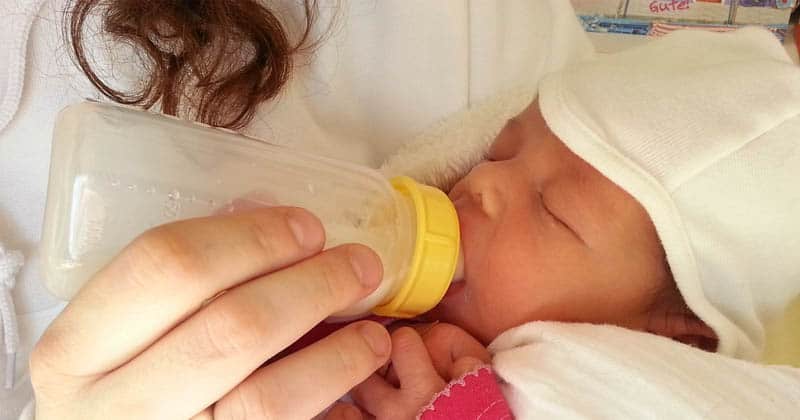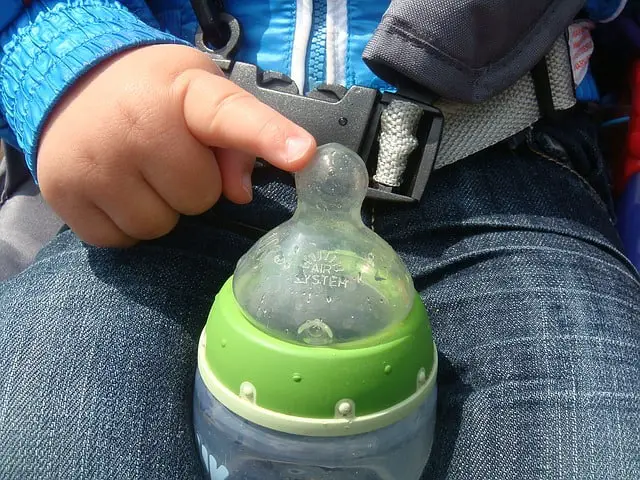There is a lot of advice about how to breastfeed successfully. But, when it comes to bottle feeding, you won’t get much more advice than maybe some tips on choosing a bottle and nipple. However, new parents could really benefit from learning a simple technique called paced bottle feeding.
What is Paced Bottle Feeding?
Also called “responsive bottle feeding” or “baby-led bottle feeding,” paced bottle feeding is a way of mimicking breastfeeding.
The basic idea behind paced bottle feeding is that you control the pace that milk comes out of the bottle (as opposed to letting the baby gulp down milk as it comes out of the bottle).
With paced bottle feeding, the baby should:
- Eat more slowly
- Be more in control of how quickly she eats
- Recognize fullness
- Work harder to get the milk (as she would with breastfeeding)
- Transition back to breastfeeding calmly
Paced bottle feeding is recommended by many doctors, lactation specialists, and health centers like the Minnesota Department of Health, Colorado Department of Public Health & Environment, Canada’s Northern Health Region, and Cuidiu, amongst others.
Breastfeeding vs. Bottle Feeding
To understand why paced bottle feeding works, you need to understand the differences between breastfeeding vs. bottle feeding.
Breastfeeding Patterns
When a baby latches onto a breast, she has to curve her tongue around the mother’s nipple and compress it against her palate. This creates a positive pressure which causes “letdown” – the release of milk from the breast.
According to research, letdown doesn’t begin until 1-2 minutes after suckling begins.
During the course of breastfeeding, a mother can have multiple episodes of letdown. The rate of milk flow will also change, typically slowing down as the child “empties” the breast. A baby will change her sucking/swallowing patterns to adapt to flow.
Bottle Feeding Patterns
By contrast, a baby only has to put the tip of the bottle’s nipple into her mouth. The tongue movement is very different than on a breast, and negative pressure is used to release milk (as opposed to positive pressure with breastfeeding).
Milk will flow continuously through the nipple. The pace stays the same. The baby has little influence over how fast the milk comes out. The shape and size of the nipple holes primarily determine how much milk comes out. (Sources: 1, 2)
Problems with Traditional Bottle Feeding
Mothers are typically warned not to introduce bottle feeding until breastfeeding is well established. Introducing a bottle too early could make it harder for mom to establish a good milk supply or result in nipple confusion.
However, the problems with bottle feeding go beyond this initial period.
The traditional method of bottle feeding – which involves shoving the nipple into the baby’s mouth and letting her gulp down milk until the bottle is empty – may cause the following problems:
Overfeeding
Because the milk flows out of bottles so easily, babies could end up eating too much, too fast. According to Futurity, Overfeeding is associated with many issues, such as belly discomfort, spitting up, gassiness, and even Type 2 diabetes.
Aside from the health risks, overfeeding can affect a mom’s milk supply. If a baby is eating too much during the bottle feed, then she won’t be as hungry when it is time for breastfeeding. The mom’s milk supply then adjusts to the reduced demand.
Difficulty Transitioning Between Breast and Bottle
Because drinking from a breast and bottle are so different, some babies have difficulty transitioning between the two. They may end up preferring the bottle because getting milk from it is easier. Paced bottle feeding mimics breastfeeding so, in theory, it is easier to switch between the two.
Risk of Obesity
Many articles on paced bottle feeding talk about how “overfeeding can lead to obesity later in life.” I am reluctant to repeat this risk because parents should NOT be worried that their babies are overweight or eating too much.
The study that is cited by these articles claiming that overeating may cause obesity is this one. It found that bottle-fed babies gained more weight than breastfed babies. However, it does not look at obesity later in life.
The researchers do theorize that bottle-fed babies might not be able to self-regulate and recognize hunger/satiety cues. But the researchers also note that there is only one pilot study that looks at babies fed breast milk by breast versus from a bottle.
While parents shouldn’t panic that their child may end up obese if they bottle-feed too quickly, it is still worth recognizing that their might be a connection and encouraging good eating habits from the start.
Not Developing Mouth Musculature
Babies often use a loose latch on bottles to slow down the flow. You’ll be able to tell the latch is loose if the bottle easily comes out of the baby’s mouth.
A loose latch means the baby is not “exercising” the muscles which are needed for breastfeeding or for eating and language skills later in life (source).
Paced Bottle Feeding Instructions
You can get started with paced bottle feeding at any time. Make sure that all your baby’s caregivers are on board so the baby can be consistently fed in the same manner from the bottle.
1. Observe Breastfeeding Patterns
If your baby is breastfeeding, it is good to observe her sucking habits on the breast before you start paced bottle feeding. This will give you an idea about how her sucking pace changes during a feeding.
2. Put Baby in an Upright Position
Babies are often bottle-fed while laying down. This means that the bottle’s nipple is always filled with milk. The milk drips constantly into the baby’s mouth, making it difficult for her to control flow. She’ll have to drink faster to keep up with the flow and might even end up making choking sounds.
When you put your baby in an upright position, she won’t have gravity working against her. You’ll also be able to control how much milk gets into the nipple by adjusting the bottle position.
Babies don’t necessarily have to be in a completely-seated position. However, keep the baby as upright as possible. See this video to learn how to sit an infant upright safely.
3. Allow Baby Take the Nipple By Herself
Instead of sticking the bottle’s nipple into baby’s mouth, let her get it herself (as she would with a breast). You want the nipple to be at the top of the tongue.
Some experts recommend putting the nipple on the baby’s cheek so she will root for it and latch on by herself. You can also try tickling the baby’s mouth with the nipple.
4. Let Baby Suck without Getting any Milk
On a breast, letdown (milk release) can take a couple of minutes to occur. To mimic breastfeeding, let your baby suck on the bottle nipple without getting any milk. You’ll have to angle the bottle downward so no milk is in the nipple.
5. Tilt the Bottle Horizontally and Let Baby Drink
You want to tip the bottle so the nipple is halfway filled with milk. Filling the nipple completely could result in the baby getting too much milk.
Though instructions vary slightly, most guides recommend letting the baby suck on the nipple for about 3-10 swallows or 20-30 seconds. It is important that the bottle is kept nearly horizontal so too much milk doesn’t get into the nipple.
6. Tilt the Bottle Downward
During breastfeeding, babies will take breaks between sucking. To mimic this with bottle-feeding, you’ll need to tilt the bottle downward so no milk is in the nipple. Do not remove the bottle from baby’s mouth! Rather, just make sure there is no milk in the nipple so baby isn’t getting any milk.
When you do this, the baby will probably stop sucking. Once she starts sucking again, tilt the bottle upwards (again only filling the nipple halfway with milk).
7. Continue with Paced Feeding
Continue with this pattern of sucking and stopping until the baby shows signs of fullness. Always stop the feeding when your baby is full, even if there is still milk left in the bottle.
As the feeding progresses, you can try to slow the pace of the milk by allowing even less milk into the nipple. This further mimics what happens during breastfeeding (less milk comes out as the breast “empties” and hind milk starts coming out).
It should take about 10-20 minutes to finish a feeding.
Signs of fullness
A big part of paced bottle feeding is being able to recognize signs that your baby is full, such as:
- No longer sucking after a break
- Pushing away the bottle or turning away from it
- Slowing down sucking
- Not opening mouth when bottle is offered
Watch out for signs that your baby is getting too much milk
If your baby exhibits any of these signs, tilt the bottle downward so your baby can take a break or to reduce the flow:
- Milk dripping from the mouth
- Choking sounds
- Splayed fingers or toes
- Pushing away the bottle
- Body stiffening
- Nasal flaring
- Eyes opening widely

Won’t Baby Suck in Too Much Air and Get Colicky?
Many articles and specialists (such as this one and this one) warn that sucking in air during feeding could cause gassiness/discomfort which leads to colic. Since paced bottle feeding involves sucking in air (through an empty or half-full nipple), does that mean paced feeding will result in colic?
First, we need to establish that there is no consensus on what causes colic. And, as this research points out, there is no scientific evidence that sucking in air causes colic.
Some lactation experts, such as those at Stanford Children’s Health, now even theorize that it isn’t swallowed air/gassiness which causes colic. Rather, it is colic that causes gassiness because babies swallow air when crying.
However, as the American Pregnancy Association points out, we DO know that overfeeding or feeding an infant too quickly can cause colic. Since paced bottle feeding prevents this, we can assume that it would help prevent colic.
The bottom line? Don’t worry that paced bottle feeding will cause gassiness or colic. It may even reduce colic. If your baby seems to get colicky after starting with paced bottle feeding, try to burp her during and after the feeding.
Best Bottles and Nipples for Paced Bottle Feeding
There are hundreds of options for bottles that you can buy. It turns out though that the bottle doesn’t matter much. Rather, it is the nipple that matters.
For paced bottle feeding, you need a nipple which has a wide base and slow flow. This type of nipple will mimic a mother’s nipple.
You’ll also want to make sure that the nipple is vented (also called an “anti-colic nipple”). In studies like this one, it was found that vented nipples help infants have a more coordinated drinking pattern and reduce gastric distress.
However, you do NOT want an anti-colic bottle. Those bottles are bent, which means milk will always be in the nipple. You won’t be able to hold it horizontally to control the flow of milk.
Have you tried paced bottle feeding? What benefits did you notice?
Additional Resources for this article:
https://www.parentinginottawa.ca/en/breastfeeding/Spoon–Cup-and-Paced-Bottle-Feeding.aspx
https://lansinoh.co.uk/paced-responsive-feeding/
https://www.healthline.com/health/parenting/paced-bottle-feeding#5
https://www.mamanatural.com/paced-bottle-feeding/
http://kindmommy.com/paced-bottle-feeding/
http://www.health.state.mn.us/divs/fh/wic/localagency/wedupdate/moyr/2017/topic/1115feeding.pdf
https://www.llli.org/breastfeeding-info/bottles/






